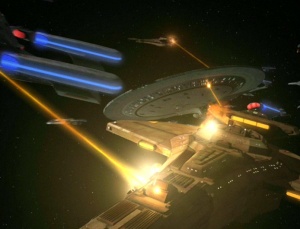Phaser Array
More actions

The term phaser array is usually used when referring to phaser types nine through eleven. These arrays consist of multiple linked emitter segments arrange in a liner array along the outer surface of a ship or star bases hull. Like all phasers in use by Star Fleet Ship mounted phaser array make use of the Rapid Nadion Effect (RNE) to generate a coherent energy beam that is the emitted from the phaser array toward a predetermined target.
The main body of the phaser array is housed beneath the hull surface in a structural honeycomb channel of duranium 235 and supplied with supersonic regenerative liquid Nitrogen cooling. The channel itself is thermally isolated from the rest of the ship structure by tritanium struts.
Phaser Array Segment Components
Power Systems:
The phaser array draws its power from the EPS network. The EPS submaser flow regulator manages the power flow via the use of physical irises and magnetic switching gates. The regulator is manufactured from combined crystal sonodanite, solenogyn, and rabium tritonide and is lined with a layer paranygen animide that provides structural surface protection.
The submaster flow regulator leads into the Plasma Distribution Manifold (PDM). The PDM is constructed of a single crystal boronite solid and feeds directly into the prefire chambers.
Prefire Chamber:
The prefire chamber is a sphere of LiCu 518 reinforced with wound hafnium tritonide. With in the chamber the plasma energy undergoes the EM spectrum shift associated with the RNE before a collapsible charge barrier allows the energy to pass into the emitter crystal. Each emitter contains three different prefire chambers, each one feeding one of the three facets of the emitter crystal.
Emitter Crystal:
The emitter crystal is a trifaceted crystal of LiCu 518. The collimated energy beam exits one or more of the facets depending on which pumped with plasma. Energy from all discharged segments passe directionally over the neighboring segments due to force coupling converging on the release point where the beam will exit the array.
Narrow beams are created by a rapid segment order firing while wider beams result form slower firing rates. It should be noted that wider beams are prone to marked power loss per unit area covered.
Phaser Control Subprocesor:
All phaser functions are controlled via the phaser control subprocesor with oversight of the main computer core and the tactical officer. The PCS is a quadritronic optical subrocessor consisting of cross connected isolinear optical chips. The PCS is linked to the ships targeting sensors via dedicated ODN network connections that allow the threat assessment/tracking/targeting software to adjust the phaser arrays firing sequence to ensure accuracy.
Phaser Array Types
Type IX

Ship mounted weapons used on ship classes such as the Ambassador class. The type nine are arranged in liner arrays.
Type X
Ship mounted weapons used on ship classes such as the Galaxy class. The type ten are arranged in liner arrays similar to the type nine.
Type XI
The type eleven phaser arrays are designed primarily for planetary defense. The type eleven are arranged in liner arrays similar to the type nine and ten. The energizing sequence of the type elevens was altered to minimize atmospheric blooming.
Some type eleven arrays have been mounted to Stations such as Deep Space Nine were they were housed in the runabout bays and raised into firing position during tactical situations.
Type XII
Use of Bravo Fleet's Phaser Array is used under the Creative Commons 4.0 License and may have been modified for AioRPG.
